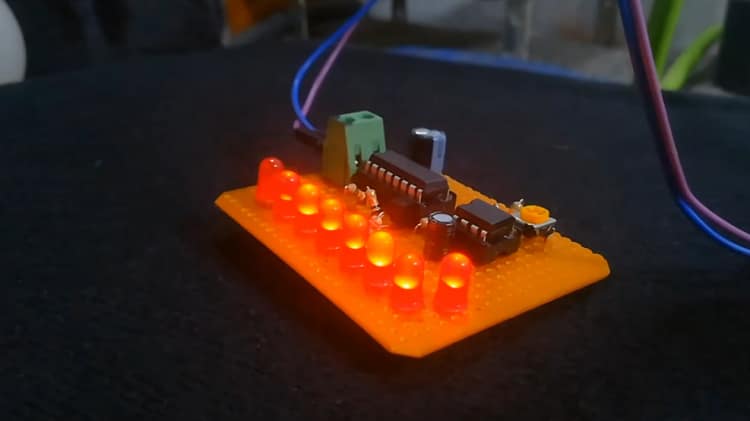This detailed guide explains how to build a Cool LED Chaser with 4015 IC circuit using a 555 timer and BC547 transistor. Learn how the Cool LED Chaser with 4015 IC works, explore the circuit diagram, and follow the step-by-step build instructions. The Cool LED Chaser with 4015 IC offers a simple and exciting way to understand digital electronics.
Whether you’re a hobbyist or a student, this Cool LED Chaser with 4015 IC project helps you explore shift registers and timing pulses effectively. Use the Cool LED Chaser with 4015 IC for decorative lights, indicators, or educational experiments. Build and test your own Cool LED Chaser with 4015 IC following our easy instructions. Dive into the Cool LED Chaser with 4015 IC design and enhance your practical electronics skills with this fun and educational circuit.
Introduction
In this project, we’ll design a Cool LED Chaser with 4015 IC — a fascinating visual effect circuit where LEDs light up sequentially, creating a moving or chasing light pattern. This type of project is common in electronics learning labs, automotive displays, and decorative lighting systems.
The 4015 IC is a dual 4-bit serial-in/parallel-out shift register, which means it can store and shift digital data with each clock pulse. By combining it with a 555 timer IC that generates clock pulses, you can create stunning LED chasing effects that look dynamic and professional.
This project is perfect for:
- Students learning digital logic circuits
- Hobbyists creating DIY LED effects
- Anyone who wants to understand shift register operation
Materials for the Project
| No. | Component | Quantity | Description | Buy Link |
|---|---|---|---|---|
| 1 | 4015 IC | 1 | Dual 4-bit shift register | Buy Link |
| 2 | 555 Timer IC | 1 | Generates clock pulses | Buy Link |
| 3 | BC547 Transistor | 1 | Amplifies or drives LED current | Buy Link |
| 4 | LED | 8 | Indicator LEDs for chasing effect | Buy Link |
| 5 | 2.2 µF Capacitor | 2 | Timing capacitors | Buy Link |
| 6 | 200K Potentiometer | 1 | Adjusts LED chase speed | Buy Link |
| 7 | 10K Resistor | 5 | Biasing and control resistors | Buy Link |
| 8 | 330Ω Resistor | 1 | Current limiting for LEDs | Buy Link |
| 9 | 2-Pin Connector Block | 1 | Power input connector | Buy on Amazon |
Circuit Diagram Explanation Cool LED Chaser with 4015 IC
The Cool LED Chaser with 4015 IC circuit mainly consists of two sections:
- Clock Generator Section (555 Timer)
- Shift Register Section (4015 IC with LEDs)
Let’s break down the operation:
1. 555 Timer as Clock Source
- The 555 timer is configured in astable mode, continuously generating square-wave pulses.
- These pulses act as the clock signal for the 4015 shift register.
- The frequency (speed of LED chasing) can be adjusted using the 200k potentiometer and 2.2 µF capacitor.
The 555 output pin (pin 3) is connected to the clock input of the 4015 IC.
2. 4015 Shift Register Operation
- The CD4015 IC contains two independent 4-bit shift registers.
- Each register can take a serial input and shift data with each clock pulse.
- When the clock pulses are applied, the data moves through the shift register, turning LEDs ON and OFF in sequence.
The serial data input is set high (logic 1) at the beginning. Each clock pulse shifts this “1” across the outputs, creating the LED chasing effect.
3. Output LED Driver
- The BC547 transistor is used to amplify current and drive the LEDs safely.
- Each LED is connected through a current-limiting resistor (330Ω) to prevent damage.
The overall result is a smooth, moving light effect that looks like the LEDs are chasing one another.
Download Circuit Diagram
Working Principle
The Cool LED Chaser with 4015 IC works on the principle of data shifting.
When the 555 timer sends pulses to the 4015’s clock input:
- Each pulse shifts the logical “1” bit to the next output pin.
- The connected LEDs light up one by one, creating the chasing effect.
- After all bits are shifted, the pattern restarts automatically.
This simple concept illustrates how digital shift registers can be used to produce dynamic visual outputs.
Applications
The Cool LED Chaser with 4015 IC can be used in many areas, such as:
- Decorative lighting displays
- Sequential signal indicators
- LED bar animation effects
- School or college electronics projects
- Automotive indicator sequences
- Learning digital electronics fundamentals
Advantages
- Easy to build and understand
- Adjustable chase speed
- Uses common components
- Works from 9V–12V DC
- Educational for understanding serial data flow
Troubleshooting Tips
| Problem | Possible Cause | Solution |
|---|---|---|
| LEDs not lighting up | Power issue or incorrect wiring | Check power supply and connections |
| LEDs blinking randomly | Loose ground or bad 555 connection | Recheck GND and 555 timing pins |
| All LEDs ON | Data input stuck high | Check data input logic and timing |
| Speed not changing | Faulty potentiometer or wrong resistor | Replace or recheck timing components |
Safety Precautions
- Always disconnect power before making wiring changes.
- Use resistors for LEDs to avoid burning them out.
- Handle ICs carefully to avoid static discharge damage.
- Double-check the polarity of capacitors before powering up.
Conclusion
The Cool LED Chaser with 4015 IC is an excellent project to explore the concept of digital shift registers and timing signals.
By combining a 555 timer with a 4015 IC, you create a simple yet captivating light chase effect suitable for learning and decoration.
Experiment by changing component values or LED colors to customize your light pattern!
Frequently Asked Questions (FAQs)
Q1. What is the function of the 4015 IC in this circuit?
The 4015 IC is a dual 4-bit shift register that stores and shifts digital data with each clock pulse, controlling the LED sequence.
Q2. How does the 555 timer work here?
The 555 timer generates continuous pulses that act as the clock input for the 4015, determining the LED chasing speed.
Q3. Can I use more LEDs with this circuit?
Yes, you can cascade additional 4015 ICs to extend the number of LEDs in the chase pattern.
Q4. What is the ideal power supply for this circuit?
A 9V DC power source is ideal, but the circuit can safely operate up to 12V.
Q5. Can I replace BC547 with another transistor?
Yes, any general-purpose NPN transistor like 2N2222 or S8050 can be used.
Q6. Why is a potentiometer used?
It adjusts the charging and discharging time of the capacitor in the 555 timer, thus controlling the LED chase speed.
Q7. Can this project be built on a breadboard?
Absolutely! It’s breadboard-friendly, making it ideal for experimentation before soldering on a PCB.


